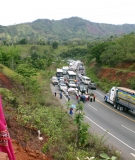Earlier this summer, I had the good fortune to meet local artist Jennifer Downey during her open studio in Oakland, CA. She had just completed her first painting in a series tentatively titled "Shifting Territories," which examines humanity's relationship with the land through the lens of dams and river diversions.

Date: Thursday, July 21, 2011 - 16:02
Kaziranga National Park in IndiaFar Horizon India ToursDuring this year's UNESCO World Heritage meeting, the World Heritage Committee issued some of the strongest language yet to countries with dam building activity in their World Heritage properties. While it awaits to be seen how this language is translated into action, it could be a positive step forward for many of the activists, experts, and dam-affected peoples who have been working tirelessly for months, and at times years, to protect their natural and cultural heritage. Thanks to their perseverance, the Committee this year has called on three countries to halt dam construction within their properties, and issued warnings to four others.
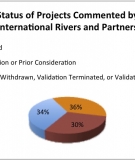
Date: Tuesday, July 19, 2011 - 07:52
Status of projects for which International Rivers and partners have submitted Commentsas of July 1, 2011For many years, International Rivers and our partners have been submitting comments on the worst hydropower projects in the CDM pipeline, raising issues ranging from environmental problems to human rights abuses to additionality. Our general experience has usually been that rather than seriously
assessing public comments, the validators, also known as DOEs, ignore any criticism of the project developers' claims. Recently, however, a number of these projects, for which we had raised serious concerns, have had their validation terminated by their DOEs. Could these DOEs finally be hearing what we've been saying for years?

Date: Wednesday, July 13, 2011 - 18:21
Photo: Saoud, FlickrMathematical errors in the classroom or on tests usually don't carry a whole lot of consequences besides a blot on your grade and maybe a deflated sense of self-esteem.But what happens when the mathematical error occurs in a major government energy agency? The ramifications could be huge, especially when a country is dead set on reducing its carbon footprint through building more hydropower projects – and it's precisely the greenhouse gas emissions from these projects that are being miscalculated.
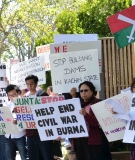
Date: Friday, July 1, 2011 - 11:02
Kachins protest at the Chinese consulate in San FranciscoKachins in CaliforniaLast Friday, hundreds of people in the US, Denmark, United Kingdom, Malaysia, and elsewhere gathered to protest the recent deadly clashes between Burmese authorities and ethnic militias in Burma's northern Kachin State. Standing before Burmese and Chinese embassies, Kachins held up signs calling for an end to the violence and a halt to dam building by Chinese companies in Kachin State.
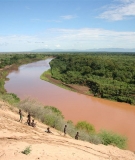
Date: Thursday, June 30, 2011 - 11:04
The Omo River Valley and Lake Turkana downstream, both home to World Heritage Sites, will be impacted by Gibe III DamAndrzej ZarzeckiThe UNESCO World Heritage Committee just concluded its 35th session in Paris, and for the activists and experts who worked long and hard to protect many dam-threatened World Heritage Sites, the results were a mixed bag.In early June of this year, 18 organizations and individuals sent a letter to World Heritage Committee members urging them to list a number of threatened sites on the List of World Heritage In Danger.
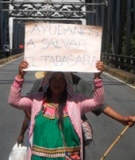
Date: Wednesday, June 1, 2011 - 10:33
Save the Tabasara RiverASAMCHIAlong with CDM Watch, we recently reported about the heavily contested Barro Blanco CDM project in Panama. A month on, protests continue, as outlined in the eye-witness report below.
Date: Monday, May 30, 2011 - 13:48
In a new feature-length documentary, Trading on Thin Air (available on Hulu and Netflix), director Susan Kucera shows that the same actors and strategies that were behind the financial crisis are currently behind today's massively lucrative carbon markets of the world – and the next big bubble. The film shows that the losers in this high stakes game are not only the climate and the environment (the supposed beneficiaries of this market's carbon offset schemes), but also the indigenous and local communities in developing countries that are being displaced by the hydropower dams, palm oil plantations, and eucalyptus farms on the receiving end of these carbon credit scams.Besides featuring a diverse group of scientists and authors on both sides of the climate change spectrum (from Nation Magazine contributor and Counterpunch editor, Alexander Cockburn to best selling author and climate change activist Antonia Juhasz to name a few), the film also features Patrick McCully, International Rivers' previous Executive Director, as well as footage and interviews of activists opposed to the Teesta Dam in India, which is currently trying to apply for carbon credits.
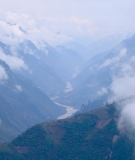
Date: Thursday, May 12, 2011 - 11:43
This is part three of a three-part blog describing my recent trip to
the Nu River valley in April 2011. All names have been changed to
protect the identity of the interviewees. Part 1 sets the scene and Part 2 introduces voices from the ground.Where to Go From Here?The Nu River from aboveKaty YanWe ended our journey with a trip to the top of a mountain. Among the clouds, at an organic tea farm set among the foothills of the Himalayas, I had a perfect view of the Nu River as it meandered through the mountains.Many mountain towns have been relocated by the government to (sometimes literally) soulless assembly-line houses by the river-some say as a form of better state control. Some villages have managed to stay, including this one. Up there in the clouds and away from the threat of dam-building, like the mountain hermits of ancient scroll paintings, we lost ourselves for a moment in our own personal reveries about the fate of the Nu valley below.

Date: Wednesday, May 11, 2011 - 12:30
This is part two of a three-part blog describing my recent trip to
the Nu River valley in April 2011. All names have been changed to
protect the identity of the interviewees. Part 1 sets the scene and Part 3 discusses the Nu
River's future."We will not move"Village near the proposed Fugong Dam siteKaty YanWhat
made the long drives along windy roads bearable were the stops we made to talk to the local people. While none of
the dams in Yunnan have been built, many villages have heard of them,
and one village has already been relocated to state-built housing.
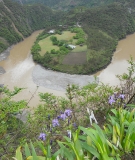
Date: Tuesday, May 10, 2011 - 15:08
This is part one of a three-part blog describing my recent trip to
the Nu River valley in April 2011. All names have been changed to
protect the identity of the interviewees. Part 2
introduces the voices from the ground and Part 3 discusses the Nu
River's future.The Nu River's first bend in northern Yunnan Province, ChinaGreen WatershedAs a Chinese American growing up in the US, I saw China's mountains, rivers and valleys through my mom's traditional scroll paintings. Idyllic villages and small cottages dot green mountainsides of bamboo, pine, and palm.My recent journey to the Nu River valley, also known as the Nujiang da xiagu ("Nu River Grand Canyon"), was nothing like stepping into one of these paintings.

Date: Tuesday, April 5, 2011 - 11:58
The Amazon River meets the sea - potential site for future non-dam salinity-based hydro?Norman Kuring/NASABattery-operated electric vehicles are cutting CO2 emissions and raising awareness of our transportation carbon footprint. Recent cutting edge research now shows that batteries can also be harnessed in rivers and estuaries as a non-dam and hopefully low-impact form of electricity generation.
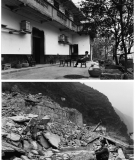
Date: Tuesday, March 15, 2011 - 18:26
Carpenter in front of his home, before and after it was demolishedLinda Butler, 2001 and 2003"Art goes around our neatly arranged arguments. Art allows us to see beauty, feel joy
and anger. Art doesn't follow a party line, but punches us in the
stomach when we least expect it."- Peter Bosshard, opening of Artists Respond to Three Gorges.For the Three Gorges Dam, the world's largest and most (in)famous dam, you could throw around some impressive facts and figures and everyone would shake their heads at them:1.3 million people displaced and 13 cities, 140 towns and 1,350 villages submerged12% of resettlement funds embezzled by corrupt officialsUp to $88 billion spent to build the project and deal with the environmental aftermath A reservoir that could stretch from San Francisco to Los AngelesWhile the list goes on, what moves the heart is not data. It's the stories and images of those most affected by the project and by the displacement and destruction it induced.
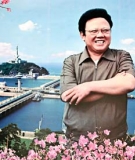
Date: Wednesday, March 9, 2011 - 18:09
A poster of Kim Jong-il in front of a dam.Alain Nogues/Corbis, The GuardianWhat do you do if you're Kim Jong-il, beloved leader of North Korea, and you're facing sanctions because of your nuclear weapons program? Jump on the carbon offset bandwagon of course! This week, Reuters reported that North Korea is trying to earn some much-needed foreign currency by selling carbon
offsets from three hydropower projects through the UN's Clean Development Mechanism.

Date: Friday, February 11, 2011 - 11:51
A community leader speaks to his people and visiting NGO representatives about Barro Blanco projectASAMCHIAs far back as the 1970s, civil society groups and the Ngobe indigenous people have been fighting to protect the Tabasara River and the lands belonging to them from destructive dam projects. The most recent such project is the 29 MW Barro Blanco Hydroelectric Project in western Panama. In late 2010, groups from across Panama and Europe were successful in prompting an investigation by the European Investment Bank (EIB) into human rights abuses, which forced the dam developer, Generating of Istmo SA (GENISA), to pull out their EIB loan request.
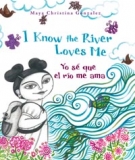
Date: Monday, February 7, 2011 - 16:53
Blues and greens swirl on the page and around a young girl who shares her love for her river. The river cools her in the summer, holds her up when she dives in, and takes takes care of her as she takes care of it. While rivers around the world are being threatened, polluted, and dammed, Maya Christina Gonzalez's book, I Know the River Loves Me, is a tribute to the relationship people, and especially children, continue to have with their rivers.
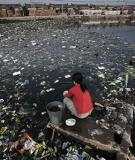
Date: Friday, January 28, 2011 - 15:56
Lu Guang, www.smithfund.orgOver 70% of China's rivers and lakes and 90% of its groundwater are polluted. In addition, large dams often gather wastewater discharge from nearby factories and farms in a toxic soup behind their gates, further exacerbating the environmental and human health crisis.
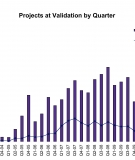
Date: Monday, December 27, 2010 - 18:07
Due to the exuberant craziness that was Rivers for Life 3 , we skipped the Third Quarter CDM update and went straight to the Fourth Quarter. To read about which projects have been "naughty or nice" (well, mostly naughty and all worthy of a large lump of coal this holiday season), see our CDM Comments page.
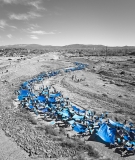
Date: Tuesday, November 23, 2010 - 12:03
350 eARTh - Santa Fe, New MexicoMichael Clark, www.michaelclarkphoto.comIn less than a week, government leaders, civil society participants, and media will be gathering in Cancun for COP16 to once again try to hammer out a climate treaty. And with it's usual impeccable timing, 350.org has once again mobilized it's worldwide supporters to send a powerful message to world leaders.
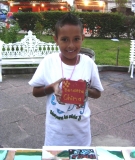
Date: Monday, November 15, 2010 - 11:18
Gibran with his tile of the Chinese flagOn the chilly Friday evening when many of the international delegates arrived for Rivers for Life 3 in Temacapulín, they were greeted not only by the meeting's coordinators, but also by many of the shorter residents of the town – Temaca's children.
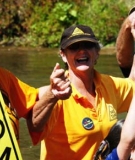
Date: Friday, November 12, 2010 - 11:07
Save the Mary River campaignThis weekend, communities throughout the Mary River Valley in Australia will be partaking in some hard-earned festivities. One year ago, Australia's Environment Minister announced the rejection of the proposed Traveston Dam on the Mary River, due to its ''unacceptable impacts on matters of national environment significance.'' The Save the Mary campaign had won.
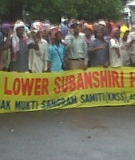
Date: Friday, September 24, 2010 - 12:00
Activists protest outside the public consultationGuest blog by Samir Mehta, South Asia Program DirectorRecently I had an exciting opportunity to be part of a Consultation on Big River Dams in Northeast India held by Environment Minister Jairam Ramesh in Guwahati, Assam. Mr. Ramesh was forced to listen to complaints about dam building in the Northeast of India during a public consultation in Guwahati, Assam. The Northeast is an isolated region of the country, with little development. While people there are clamoring for improvements to the region, they know dams are not the way to go.

Date: Friday, August 27, 2010 - 16:19
Bhagirathi River at Gangotri, Uttarakhand, IndiaAtarax42For the third year in a row, one of India's most eminent scientists, Professor AD Agarwal, has carried out a "fast-unto-death" in protest against the 600 MW Loharinag Pala hydropower project in Uttarakhand, India. Last year, project construction stopped after Prof. Agarwal came close to dying on the 38th day of his fast, only to resume a year later.Earlier this week, lead by the Finance Minister Pranab Mukherjee, a group of ministers (GoM) announced they would scrap the project completely. As part of the decision, the government has created India’s first dam-free zone in the ecologically sensitive area, through which the river will flow freely for 135 kilometers. Prof. Agarwal has called off his fast as environmental, religious, and social justice groups rejoice at the news.

Date: Thursday, August 26, 2010 - 23:19
Leonardo da Vinci (1452-1519)www.vivoscuola.it"The body of the earth is of the nature of a fish...because it draws water as its breath instead of air," said the Italian painter, scientist and engineer Leonardo da Vinci.Block that flow of life with a massive concrete dam, or clog it with a thick solution of toxic chemical and organic pollution, and the earth grows sick. This is not just poetic metaphor, but reality for communities living along the Mekong, the Amazon, the Omo River, and so many others.
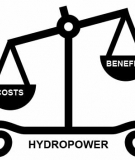
Date: Thursday, August 19, 2010 - 16:08
In weighing the costs and benefits of large-dam hydropower within the context of climate change, how do the scales add up?You've heard us talk about how large reservoirs contribute to climate change through the emission of methane, how dams make rivers less resilient to climate change, threaten biodiversity, and of course, displace thousands of people upstream while negatively impacting thousands more downstream. That's the costs side.
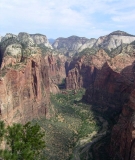
Date: Friday, August 6, 2010 - 15:15
Zion Canyon and the unassuming Virgin River that created it. Utah is a member of the WCI.I recently returned from a long-awaited trip to Zion and Bryce canyons in Utah, two geologically fabulous places carved largely by the forces of rivers and rain. A few major climate developments met me back at the office: federal climate legislation had died, western states and provinces in the US and Canada took one step closer to addressing climate change despite federal inaction, and the great Steve Schneider (who taught me and so many others that being a scientist doesn't mean taking a backseat in policy-making) had passed away. May he rest in peace.
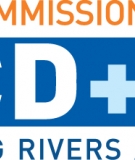
Date: Tuesday, July 20, 2010 - 23:14
The most comprehensive guidelines for large dams that protect the rights of river-dependent communities were outlined by the World Commission on Dams (WCD) report in 2000. When it was published, dam-affected communities and their allies worldwide celebrated its recommendations, which charted a better way forward for dam-building and community-centered development.

Date: Monday, July 12, 2010 - 09:39
Update: The number of projects that entered the CDM pipeline increased in the first two quarters of 2010 (See Fig. 1). The percent of registered projects that were involved in the review process (which includes projects that require corrections) has been growing over the years (see Fig. 4): 9.5% in 2005, 9.1% in 2006, 19.3% in 2007, 56.9% in 2008, 70.4% in 2009, 53.7% in 2010 (as of July 1, 2010). 50% of all hydro projects in the CDM pipeline have requested registration since 2004, while 44% of all hydro projects have actually been registered. Figs. 3 and 4 show the fate of projects requesting registration and being registered by year. Hydro projects continue to be the most prevalent type of project in the CDM pipeline (28% of all projects). 63% of credits expected from hydro projects come from China

Date: Thursday, June 10, 2010 - 13:34
Could a decrease in offsets mean an increase in energy efficiency?www.gadgetking.com/trends/oligopoly+graphThe latest Clean Development Mechanism Executive Board meeting ended right after a new World Bank report was published saying that investment in the CDM fell by 59% in 2009 (State and Trends of the Carbon Market).



